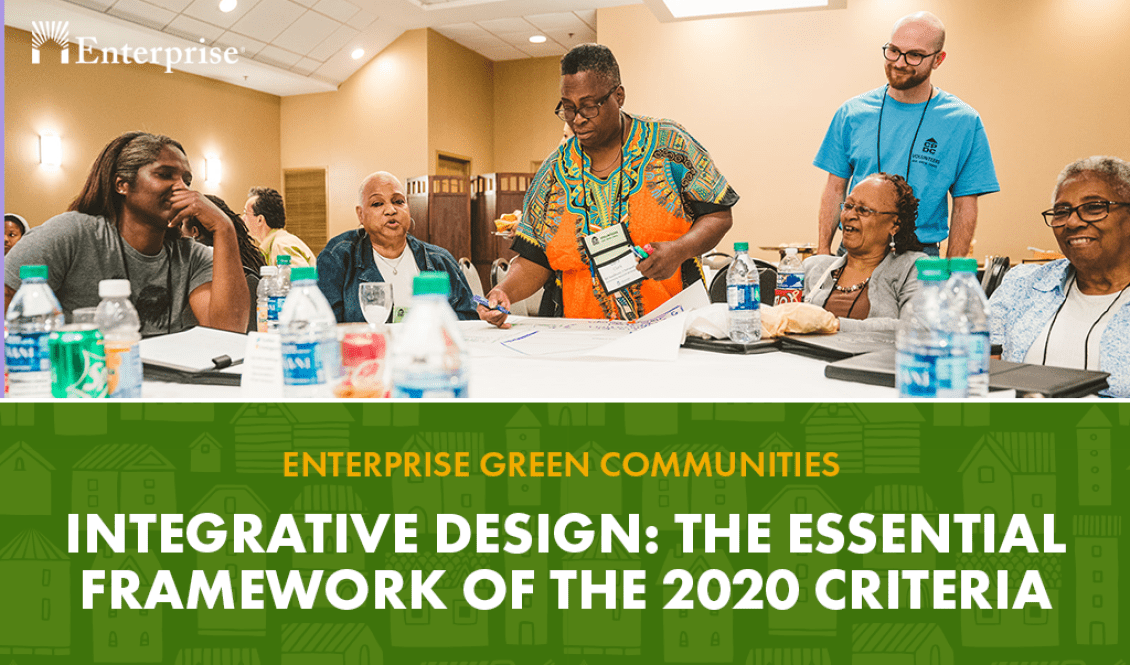This is the first in a blog series exploring five themes critical to affordable housing development and central to the 2020 Enterprise Green Communities Criteria: path to zero energy, healthy housing, water and resilience.
Since the first iteration of the Enterprise Green Communities Criteria, the practice of integrative design has helped ensure a holistic approach to predevelopment that allows project teams to develop and meet relevant goals.
The practice of integrative design requires gathering information, prioritizing residents’ experiences, setting objectives for building performance and resident health and comfort, and securing buy-in from all stakeholders. These strategies establish collective priorities from the beginning and ensure they are clearly communicated throughout the design and construction of the development.
Integrative design also prevents development teams, especially majority-white development teams working in primarily Black and brown communities, from falling into the familiar pattern of thinking they know what’s best for residents. Interactive meetings and charrettes provide critical knowledge sharing opportunities, allowing the development team to listen and respond to needs and priorities of future residents and community members. Together, these practices can advance racial equity by shifting patriarchal dynamics and empowering residents and their community.
The 2020 Green Communities Criteria – the latest iteration of the 15-year-old criteria – deepens the commitment to integrative design with the refinement of key activities and additional tools for project teams.
As a reminder, after October 15, 2020, the 2015 criteria will be retired from use with new projects and all new prebuild applications must be submitted with the 2020 Green Communities Criteria.
Integrative Design: What’s New?
The Integrative Design category in the 2020 Green Communities Criteria includes mandatory and optional criteria. The four mandatory criteria below focus on establishing development goals and priorities as well as processes to ensure open communication throughout the development process.

Making an important shift to the integrative design process, the 2020 criteria explicitly lifts resident preferences and directly responds to climate change through the Project Priorities Survey (PPS). All sections of the PPS are required, giving project teams framework to focus on resident-centered sustainability approaches.
An important addition is the new 1.7 Cultural Resilience criterion, integrating strategies that, for the first time, specifically promote resident participation and cultural leadership as part of the design, development and community planning process. Learn more about cultural resilience, especially during the Covid-19 pandemic.
Integrative Design: Why it Matters
Traditional design and construction practice occurs in silos, often separated by disciplines. If a practitioner, such as the architect, receives important information from the client or residents, they don’t have a method for sharing and discussing it with other team members. At best, practitioners miss opportunities to find better solutions; at worst costly conflicts emerge that involve rework.
The integrative design criteria align stakeholders around a common purpose and create a common level of understanding. They also enhance team communication through information sharing, charettes and regular meetings.
Enhanced communication and goal setting benefit the design and construction team, while ensuring residents receive the benefits of green building. The integrative design process bakes mandatory and selected criteria into the architectural design, promising that the building is constructed ;to the correct specifications and functions properly when residents arrive.
Does integrative design make a difference? Based on an Enterprise study, the answer is unequivocally yes:
When criteria measures are clearly incorporated in the plans and specifications of a project, those measures are 95% more likely to appear within the property. However, if not properly documented, these measures appeared within the property only 37% of the time. We also found that when a project team incorporated the criteria late in the design process, they experienced higher development costs and variable outcomes in building performance.
The Project Priorities Survey
The most significant integrative design change in the 2020 criteria is the inclusion of the Project Priorities Survey (PPS). This fillable template walks the project team through a step-by-step process to collect information from residents and the surrounding community, and identify potential climate and environmental vulnerabilities.
Enterprise has piloted efforts to merge data mining and ground truthing using Health Action Plans, which, like the survey, provide template for collecting information. Those efforts indicate that discussing the data with community members can uncover important nuances and clarify priorities.
For example, the Gulf Coast Housing Partnership gathered data and shared with the future community. While data indicated a high incidence of crime in the community, residents said they felt the neighborhood was safe and shared concerns about other threats beyond crime.
The project team determines when to complete the survey. Ideally, it should be completed early enough in the design phase (during conceptual design or schematic design) to influence design decisions as they are made. Project teams planning to use the 2020 criteria are advised to download the Enterprise Green Communities 2020 Criteria.
